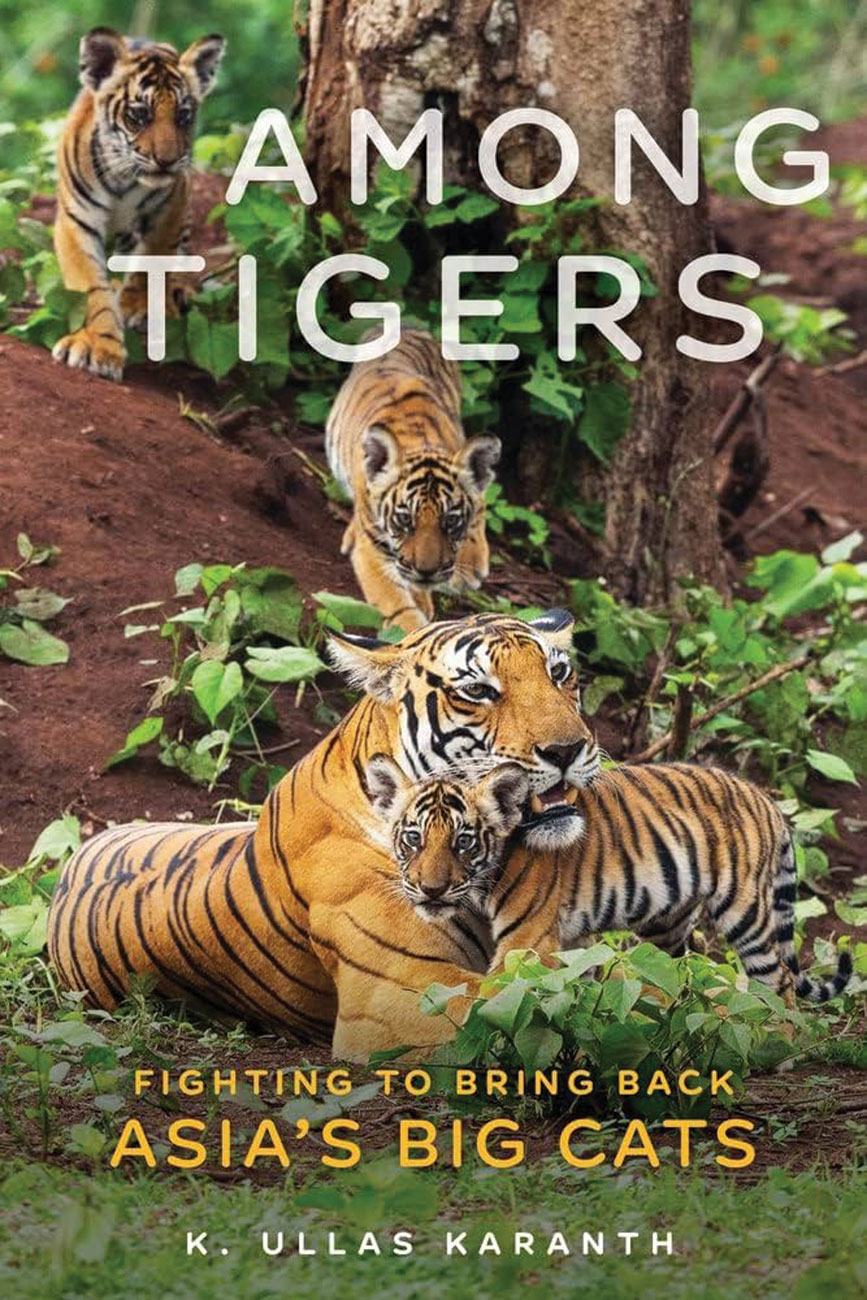Book Review: Among Tigers: Fighting To Bring Back Asia’s Big Cats
First published in Sanctuary Asia,
Vol. 43
No. 12,
December 2023
With improved technology and a much greater appetite among the young for books to remind them of the wonderful biosphere in which they live, it is heartening to see how many new, high-quality publications are emerging from within India. Here are books that Sanctuary believes should be in every public library and in the homes of all those whose hearts beat to nature’s drum.
Among Tigers: Fighting to Bring Back Asia’s Big Cats
By K. Ullas Karanth
Published by Chicago Review Press
Hardcover, 256 pages, Price: Rs. 1,499

Dream big. Act boldly. And imagine an India with 15,000 tigers… is this number far too unreal? Not for Dr. K. Ullas Karanth, India’s tiger biologist par excellence, who has time and again drawn up plans and implemented models to ensure that not only is the striped cat protected, but that it also thrives, all of which he presents in convincing detail in his absolutely absorbing book.
Dr. Karanth’s book, his autobiography and in many ways the biography of tigers in India, brings us the astounding saga of his seven-decade-long love for the tiger and its habitat. He is the first in India to radio-collar tigers and track them, and conduct the first major study on tigers and leopards in India. His adventures in the forest, harrowing interactions with rioting locals who misunderstand his work, troubles with the tricky political, bureaucratic and judicial system, and his deep focus on truly understanding the tiger and devising ways to conserve it, are described in evocative language. Dr. Karanth’s journey from being besotted by tigers as a young person, to becoming a tiger biologist, a conservationist, and then moving into tiger counting and strategy building at a large scale, shows the fascinating evolution and long-standing and almost stubborn commitment to the wild.
The book opens in Nagarahole with detailed accounts of tracking tigers and leopards, radio-collaring them, and then studying them over several months to understand their behaviour. The way he conjures up the dramatic jungle scenes takes me to another time… Jim Corbett’s jungles. For instance, he writes: “A pile of dry leaves a little more than an arm’s length from me suddenly rose in a swirl, and morphed into a leopard! A few more paces and I would have stepped on Mooga. He scurried away, dashed down the embankment into some thick sedges on its banks of the rivulet, and clambered up the other side.” Dr. Karanth’s adventures brought the forest alive in my home, and the nostalgia it evoked was an added hook.
Studying the tiger and conservation action is not easy by any means. His pioneering work involved painstaking efforts, personal sacrifices, and an acceptance of strange tasks. He writes of his christening as the Moole (bones) Ranger, owing to his vast collection of prey skulls, and his “labour of love” collecting animal scats – 1,329 scats to be exact (490 from tigers, 535 from leopards, and 304 from wild dogs)! At a time when all he wanted to do was study his beloved tiger, tabloid journalists hounded him, politicians set up obstructions, and bureaucrats played by their own rules. His interactions with these arms of our democratic system left me wringing my hands, worrying about the fate of the wild. Dr. Karanth however, remains steadfast, driven by his faith… “Saving the tiger is a matter of faith”, he writes.
While the circumstances of the tiger and the intricacies of its existence in India are bound to be relatable for someone from the country, I think that the style of writing will open up this complex world of the striped cat to an international audience too, giving the extremely localised behaviour of animals and people the global importance they deserve, since after all, the earth is one pulsating organism.
The book is written in an honest and straightforward manner, and his strong opinions become easier to reflect on, like his support for advanced agricultural biotechnology. I also like that animal behaviour is not seen from an anthropogenic lens of good and bad, like this: “He was in musth – a condition like the rut in stags – during which tuskers are at their aggressive best.”
The author is not unfazed about how ‘popular’ opinions and majority voices would react to hard but correct decisions based on science and years of experience in the wild. He does not shy away from calling a spade a spade – whether it is local ruffian politicians, government bodies, poorly informed activists, or the World Bank.
Dr. Karanth’s book is for anyone on the path to species monitoring, census methodology and conservation in the real world, or even the history of the tiger in India. He also exhorts everyone to be seriously involved in the mission to protect tigers. Ultimately, he leaves us with hope… “If we can pragmatically accommodate these [the tiger’s] needs within the frame of human needs and aspirations, there is still plenty of room for wild tigers to bounce back.
Reviewed by Shatakshi Gawade.


